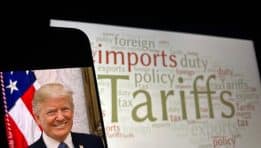Impact of U.S. Tariffs on South Korean Semiconductor Giants: Samsung and SK Hynix
The recent stance of the trade envoy from South Korea regarding U.S. tariffs on semiconductors has stirred significant interest in the global markets. The envoy has announced that major tech players, particularly Samsung and SK Hynix, will not face the looming threat of 100% tariffs on chips imported into the United States. This declaration is pivotal, especially given the massive stakes involved in semiconductor performance on a global scale.
The semiconductor industry has always been contentious, especially within U.S.–China trade relationships. As key manufacturers in this sector, Samsung and SK Hynix play an essential role in the supply chain for various electronic devices, including smartphones, computers, and servers. The South Korean trade envoy’s reassurance is crucial, providing stability amid turbulent trade discussions.
Let’s delve into how this development will affect both companies and the broader semiconductor landscape:
Potential Impacts on Samsung
Samsung, the world’s largest semiconductor manufacturer, stands to benefit significantly from the South Korean envoy’s remarks. With U.S. tariffs potentially off the table, Samsung can:
- Maintain competitive pricing: By avoiding steep tariffs, Samsung can keep its prices more competitive within the U.S. market, making its products more appealing to consumers.
- Foster innovation: The company can focus financial resources on research and development rather than compensating for tariffs, which can lead to advancements in technology.
- Secure partnerships: With positive news regarding trade regulations, Samsung may find it easier to forge partnerships with U.S. companies and enhance its market footprint.
Implications for SK Hynix
For SK Hynix, this announcement is equally advantageous. The company is the second-largest memory chip producer globally, and it faces similar opportunities:
- Boost exports: The absence of tariffs means SK Hynix can export its chips to the U.S. without added costs, leading to increased sales and revenue growth.
- Investment opportunities: With a clearer trade landscape, SK Hynix can confidently invest in expanding its production capabilities and enhancing technology.
- Market expansion: The company might consider extending its reach into the U.S. market further, possibly targeting emerging technologies and sectors requiring advanced chips.
Broader Market Considerations
The news about Samsung and SK Hynix is timely, given the global semiconductor shortage witnessed over the past few years. The absence of tariffs can have the following effects on the broader market:
- Increased supply: As these companies ramp up production without tariff concerns, the overall chip supply will likely improve, helping to alleviate shortages.
- Pricing stabilization: A healthier supply chain can lead to stabilization of prices in the semiconductor market, which has been volatile due to disruptions.
- Innovation across sectors: Easier access to advanced chips allows various industries—from automotive to consumer electronics—to innovate and improve their products.
While this news brings a wave of optimism, challenges still persist. The geopolitical landscape remains complex, especially with ongoing tensions between major powers like the U.S. and China. Stakeholders must remain vigilant, as conditions can change rapidly.
The South Korean trade envoy’s statement brings much-needed clarity to Samsung and SK Hynix amid an uncertain trade environment. By avoiding 100% tariffs on chips, both companies can navigate the competitive tech landscape more effectively. Their growth potential can simultaneously contribute to the stabilization of the global semiconductor market. It’s a situation to watch closely, as developments in this sector will likely have lasting impacts on various industries in the years to come.
The Future of Global Chip Trade and Technological Alliances in Asia
The global landscape of chip trade is rapidly evolving, driven by technological advancements and international partnerships. In the heart of Asia, countries are forging strong alliances to bolster their semiconductor industries. These shifts are crucial as they deal with global supply chains and navigate complex trade dynamics. Understanding the future of chip trade involves examining key players, emerging technologies, and strategic collaborations.
When we think about the semiconductor industry, Samsung and SK Hynix stand out as giants. Recently, assurances have been made that these South Korean companies will not face 100% U.S. tariffs on their chips. This news is significant because it stabilizes the market and promotes continued collaboration between Asian manufacturers and global tech firms. The harmony in trade relations encourages innovation, driving the industry to new heights.
As nations look to enhance their competitive edge, we see a surge in investments in semiconductor technology. For instance, countries like Taiwan, Japan, and South Korea are accelerating their chip production facilities. Here are a few reasons why this is happening:
- Increased demand: The demand for semiconductors continues to soar with the rise of artificial intelligence, Internet of Things (IoT), and 5G technology.
- Supply chain resilience: Companies are focused on creating more resilient supply chains to avoid disruptions witnessed during global crises.
- Technological advancements: Innovations such as quantum computing and advanced AI continue to push the boundaries of what chips can do.
The future of global chip trade also hinges on the technological initiatives from various governments. Many Asian countries are investing heavily in research and development to enhance semiconductor capabilities. Singapore, for instance, is establishing itself as a hub for research in chip technology. By fostering an ecosystem for innovation, countries can ensure a strong foothold in the global market.
Strategic alliances between tech companies are essential in this evolving arena. Collaborations can lead to shared resources, advanced technologies, and broader market reach. South Korea’s semiconductor industry has already seen successful partnerships. For example:
- Joint ventures: Companies are creating joint ventures to develop cutting-edge technology and increase production capacity.
- Collaborative research: Collaborative research programs allow industries to innovate while sharing the risk and cost associated with development.
In addition, the geopolitical environment plays a significant role in shaping the semiconductor trade. Countries are becoming more cautious, and trade policies are evolving. Recently, the potential for U.S. tariffs on chip imports has raised concerns among Asian manufacturers. South Korea’s trade envoy’s confirmation that Samsung and SK Hynix would not be fully subjected to these tariffs is a reassuring factor for stability in the region’s chip market.
You might wonder how these trade dynamics affect you personally. The chips manufactured by these companies are the backbone of many devices we use daily. From smartphones to laptops, advancements in semiconductor technology can lead to improved performance, enhanced features, and more competitive pricing for consumers.
Looking ahead, sustainability will also become a key focus in the chip manufacturing process. As environmental concerns grow, manufacturers are adapting to create greener technologies. This shift not only aligns with consumer expectations but also opens up new opportunities for innovation. For example:
- Eco-friendly materials: Research is ongoing into alternative materials that reduce carbon footprints.
- Energy efficiency: Chips are being designed to consume less power without sacrificing performance.
The future of global chip trade in Asia is shaping up to be dynamic and interconnected. With major players like Samsung and SK Hynix taking steps to ensure stability amidst changing tariffs, the semiconductor landscape is brimming with opportunities. As nations continue to invest in technology and build alliances, the implications of these developments will echo across industries, ultimately benefiting you as a consumer in varied ways.
As we navigate this exciting phase in the global chip trade, staying informed about technological advancements, international partnerships, and trade policies will be key. The interplay of these factors will not only determine the direction of the semiconductor industry but also impact everyday technological experiences for people around the world.
Conclusion
The recent statement from the South Korean trade envoy regarding Samsung and SK Hynix not facing the brunt of 100% U.S. tariffs on chips has shed light on the ongoing dynamics of the global semiconductor market. For South Korea’s semiconductor giants, this announcement not only provides relief but also demonstrates the strategic importance the U.S. places on these companies in maintaining a competitive edge in technology. This alleviation of tariffs may encourage continued innovation and investment in chip manufacturing, which is crucial amidst growing global demand.
As we navigate the complexities of international trade, the implications extend beyond just tariff measures. The evolving landscape of technological alliances in Asia signals a shift towards collaborative advancements in the semiconductor field. Countries within the region may strengthen ties to foster innovation, creating a robust network that enhances their standing in the global market. This interconnectedness may lead to more resilient supply chains and establish Asia as a focal point for chip production.
Looking ahead, the semiconductor trade will likely continue to be a pivotal factor in international relations and economic strategies. South Korea’s leadership in technology, bolstered by its semiconductor giants, positions it well in this competitive landscape. As trade policies evolve, the focus will be not just on surviving tariff fluctuations but on harnessing opportunities for growth through collaboration and technological advancements. The future of the chip trade remains promising, as companies adapt and innovate in response to an ever-changing global economy.
Comparison, examination, and analysis between investment houses
Leave your details, and an expert from our team will get back to you as soon as possible
* This article, in whole or in part, does not contain any promise of investment returns, nor does it constitute professional advice to make investments in any particular field.
To read more about the full disclaimer, click here- Lior mor
- •
- 16 Min Read
- •
- ago 2 hours
 Shares in South Korean Chipmaker SK Hynix Tumble on US Tariffs
Shares in South Korean Chipmaker SK Hynix Tumble on US Tariffs
The Impact of U.S. Tariffs on Shares in South Korean Chipmaker SK Hynix The ripple effect of U.S. tariffs can
- ago 2 hours
- •
- 16 Min Read
The Impact of U.S. Tariffs on Shares in South Korean Chipmaker SK Hynix The ripple effect of U.S. tariffs can
- Ronny Mor
- •
- 16 Min Read
- •
- ago 2 hours
 Trump’s Broad Tariffs Go Into Effect, Just as Economic Pain Is Surfacing
Trump’s Broad Tariffs Go Into Effect, Just as Economic Pain Is Surfacing
The Impact of Trump's Broad Tariffs on the U.S. Economy Amid Rising Economic Challenges The implementation of broad tariffs by
- ago 2 hours
- •
- 16 Min Read
The Impact of Trump's Broad Tariffs on the U.S. Economy Amid Rising Economic Challenges The implementation of broad tariffs by
- orshu
- •
- 9 Min Read
- •
- ago 2 hours
 Global Markets Recap: Wednesday, August 6, 2025 Performance Review and What to Expect for Thursday, August 7
Global Markets Recap: Wednesday, August 6, 2025 Performance Review and What to Expect for Thursday, August 7
Overview of August 6 Market Movements Across Americas, Europe, and Asia On Wednesday, August 6, 2025, global financial markets showed
- ago 2 hours
- •
- 9 Min Read
Overview of August 6 Market Movements Across Americas, Europe, and Asia On Wednesday, August 6, 2025, global financial markets showed
- sagi habasov
- •
- 16 Min Read
- •
- ago 3 hours
 Montrose (NYSE: MEG) Surprises with Strong Q2, Stock Jumps 24.7%
Montrose (NYSE: MEG) Surprises with Strong Q2, Stock Jumps 24.7%
Analysis of Montrose (NYSE: MEG) Q2 Financial Performance and Market Impact Montrose Environmental Group, Inc. (NYSE: MEG) reported an impressive
- ago 3 hours
- •
- 16 Min Read
Analysis of Montrose (NYSE: MEG) Q2 Financial Performance and Market Impact Montrose Environmental Group, Inc. (NYSE: MEG) reported an impressive












